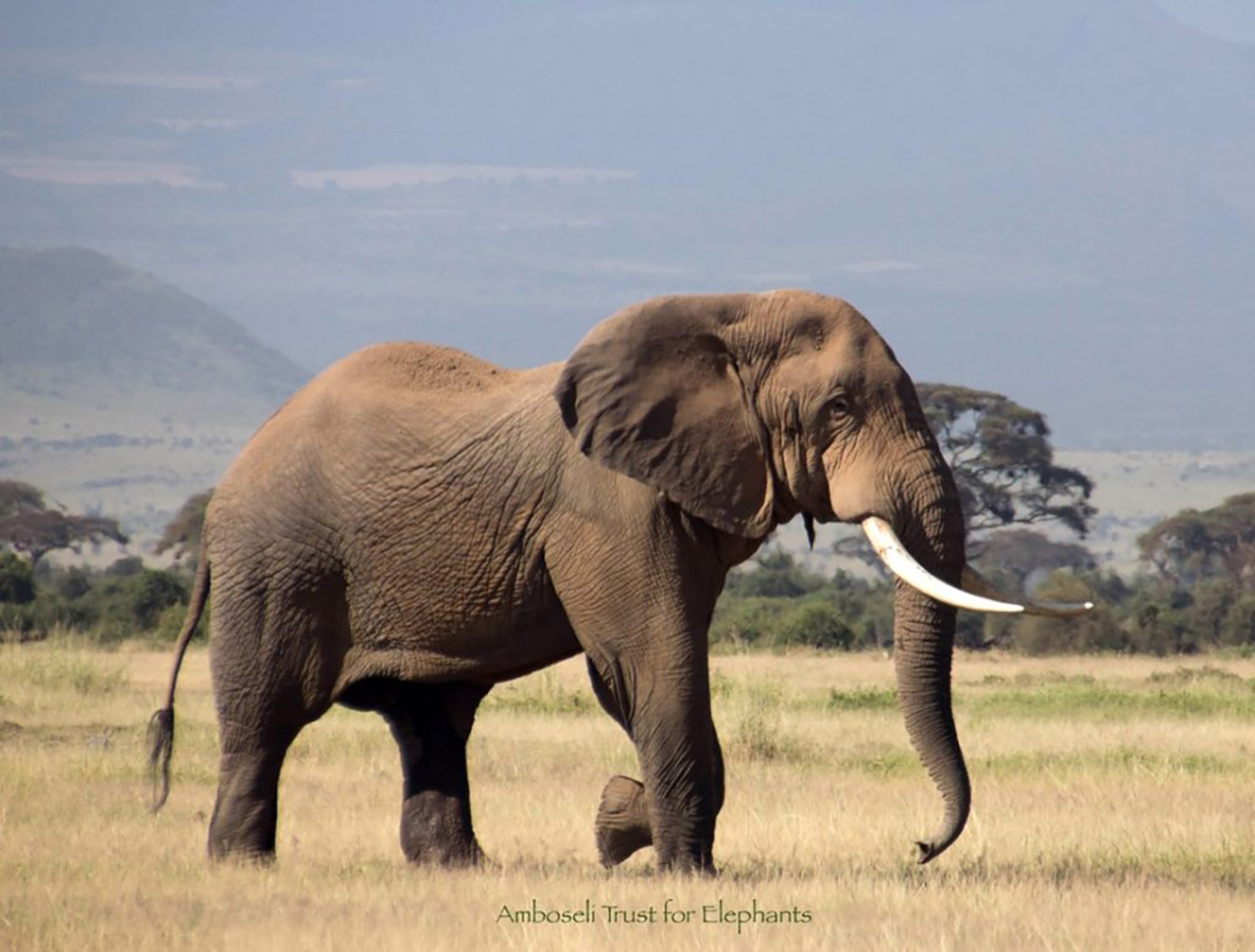The 35-year-old super-tusker, who was just entering his reproductive years, belonged to a unique population of elephants who traverse from Kenya’s Amboseli National Park to northern Tanzania.
Super-tusker elephants —who have at least one tusk weighing over 50 kilograms —were decimated in the past by poachers. Less than 100 now remain.
“The unnatural death of any elephant is very troublesome,” said Cynthia Moss, program director at Amboseli Trust for Elephants, who has been studying this population for 51 years. "What we are trying to do as scientists is to study as natural a population as possible. So to kill an elephant just because it has big tusks goes against everything we have strived for."
Kenya banned hunting in 1977 but it remains legal in Tanzania — where hunting companies can obtain licenses on behalf of a client. A permit to shoot an elephant costs between US$10,000 to $20,000.
However, for the last three decades, the Kenyan-Tanzanian border had been relatively safe for elephants –– until Gilgil was shot and his carcass was burnt. Then in November, another elephant was killed in Tanzania, followed by one more last month.
That seems to have marked the end of a de-facto hunting ban, which came in 1995 after pressure from Moss and other conservationists. This had followed the hunting down of four elephants in the frontier region. According to a report at the time, Kenya and Tanzania agreed to enact a temporary ban along their border, until they decided how to best manage hunting.
“The understanding was that this would be a firm and enduring agreement that elephants would not be hunted on the Tanzanian side,” recalled David Western, former head of Kenya Wildlife Service who took over in 1994. “Hunting would have started much, much sooner otherwise.”
In a statement last month, Joseph Ole Lenku, Governor of Kajiado County in Kenya, which is the custodian of Amboseli National Park, called upon his “counterparts on the Tanzanian side to carefully consider the long-term implications of such actions and to join us in preserving our shared natural heritage for future generations.”
Over 50 organizations petitioned Tanzanian President Samia Suluhu to order an immediate ban on elephant trophy hunting. The U.S. also just announced it will ban African elephant hunting trophy imports.
But in Tanzania, the industry has boomed in recent years, generating millions of dollars annually for the country, and bringing in hunters from across the world, particularly from the U.S.
The Tanzania Wildlife Management Authority, Office of the Tanzanian President and Kenya Wildlife Service did not respond to requests for comment.
The first and third hunts of the Amboseli elephants were conducted by Kilombero North Safaris. According to public documents, the Tanzanian company bought two concessions in 2022 — awarded for a ten year period — for over $250,000.
In an email to OCCRP, Zidane Janbeck and Quintin Whitehead, managers of Kilombero, said they legally conducted the safaris in “strict adherence to Tanzanian law” in a “community wildlife area allocated to the company.” Kilombero also says the hunting ban was only in effect for one season.
They disputed that the elephant was Gilgil from photographic evidence. “The 2016 picture of Gilgil displays a normal toe structure and it does not match the one we harvested at all,’ they said.
Moss said she identified Gilgil from photographs taken after the elephant was killed but before the carcass was burned. An elephant’s skin, with its unique features, is basically a giant fingerprint, the Amboseli Trust for Elephants claims. Gilgil had been sighted 158 times in the park, according to scientists.
 Gilgil in 2016 when he was 28 years old, according to Amboseli Trust for Elephants. (Photo: Amboseli Trust for Elephants)
Gilgil in 2016 when he was 28 years old, according to Amboseli Trust for Elephants. (Photo: Amboseli Trust for Elephants)
Photographs posted on the Kilombero Facebook page show hunters proudly standing with guns next to the animals they killed, including a large dead elephant. “This bull stands as a testament to our area’s quality, conservation efforts, and teamwork,” one post reads. “Without hunting, there will be no conservation.”
Trophy hunters often claim they are contributing to conservation efforts as the income from hunting safaris conserves the land and biodiversity, and removes older less fertile animals.
“We are strong believers in conservation through sustainable utilization,” Janbeck and Whitehead told OCCRP. “The knock on effect of this influx of cash has been vast improvement in the quality of life of the local communities.”
However, conservation activists argue this is not the case, and that elephants like Gilgil were in their prime breeding years. “There are just so many myths, and misinformation about the role these larger male elephants play,” said Moss from the Amboseli Trust. “Our studies show that the bigger older males do all the breeding and well up into their 50s.”
 Staff of the Amboseli Trust for Elephants putting a collar on independent male Esau, who regularly traverses between Kenya’s Amboseli National Park and neighboring Tanzania. The collar will help track Esau’s movement and protection. (Photo: Amboseli Trust for Elephants)
Staff of the Amboseli Trust for Elephants putting a collar on independent male Esau, who regularly traverses between Kenya’s Amboseli National Park and neighboring Tanzania. The collar will help track Esau’s movement and protection. (Photo: Amboseli Trust for Elephants)
Kilombero’s website offers “exclusive tailor made safaris… for the discerning elephant hunter.” Five day safari trips in Tanzania start at over $17,000, but that “does not include any dangerous game,” Janbeck and Whitehead told OCCRP. “Only on a premium license are elephants, lions and leopards available.”
Kilombero North Safaris is owned by Akram Aziz, brother of Rostam, Tanzania’s first billionaire, according to Forbes.
According to Instagram posts, three Americans were hunting with Kilombero in northern Tanzania last month, around the time of the third elephant killed after Gilgil. Pictures show Rick Warren, a Texan former oil and gas executive, Aaron Neilson, a Colorado man who, according to Forbes, once killed 15 lions in Tanzania, and John Lewton — once sentenced in U.S. federal court for sheep hunting — posing with a variety of dead animals.
Neilson and Lewton did not respond to emailed requests for comment.
“I don’t know how my name got associated with an Elephant hunt,” Warren told OCCRP in an email. “My last Tanzania Elephant taken was in 2014 in the Selous Game Reserve.”
“Hunter dollars protect more wildlife habitat globally in a single year than all the activists put together do in a lifetime,” Warren continued.
This is disputed by conservationists.
“In Kenya, millions of dollars have gone into studying and protecting these elephants over decades, only for them to walk into Tanzania and be shot,” said Joyce Poole, co-founder and director of Elephant Voices. ”It’s just wrong on so many levels.”
Social media posts indicate that another hunted elephant is an imminent possibility. On April 5, Lewton — who was on the last hunt — posted a picture of a large elephant with the caption, “I am back in Tanzania for a few more weeks… This Elephant was not happy with us in the area! We left him with his cow.”



